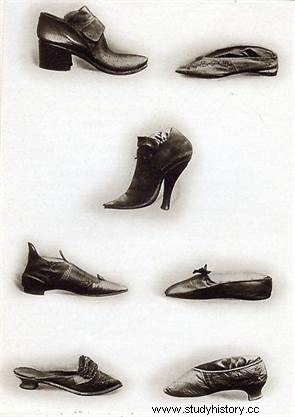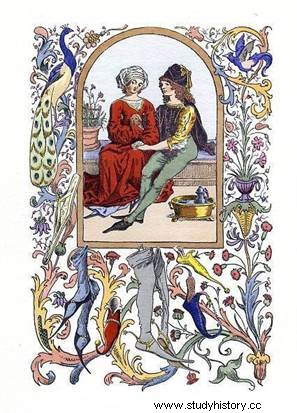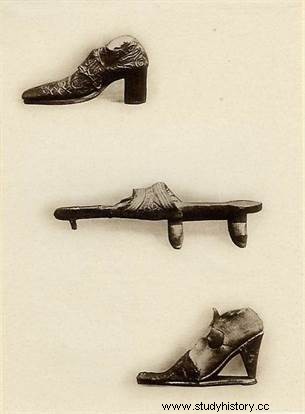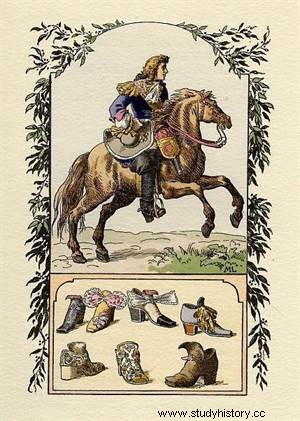 The foot and its shoe have always had a crucial place in humans, since the dawn of time. System of measurement used for a long time, we talk about it in history, literature, proverbs, like this "it is not essential to live on a big foot, but by striving to live on a reasonable foot, by trying to find shoes that fit, we will never be barefoot”. And remember in your childhood when your parents told you the story of Tom Thumb, Puss in Boots or Cinderella and her vair slipper! How was the shoe born, how has it evolved over time?
The foot and its shoe have always had a crucial place in humans, since the dawn of time. System of measurement used for a long time, we talk about it in history, literature, proverbs, like this "it is not essential to live on a big foot, but by striving to live on a reasonable foot, by trying to find shoes that fit, we will never be barefoot”. And remember in your childhood when your parents told you the story of Tom Thumb, Puss in Boots or Cinderella and her vair slipper! How was the shoe born, how has it evolved over time?
Who invented the shoe?
Shoes were born at the same time as humans, but before wearing clothes, humans put on shoes to protect their feet from more or less painful contact with the ground. He wraps it in an animal skin and makes a sole of bark or wood. As many documents attest, the shoe is thus the basis of the costume. In antiquity, some Greeks or Etruscans were naked but wore "crépides", these sandals with straps wrapped around the leg to hold the sole, like Caius the Roman emperor, proud of his shoe made of purple leather. A kind of boot!
The principle of protecting the foot will remain, but with fashion, shape, colors, names will change. The shoes are initially galoshes, “galliculae” with wooden soles; then in the 7th century, they are made of dark leather, the foot taken in a vamp, the heel retained in a high quarter, provided with two ears and tightened by a cord.
From Charlemagne's shoe to the poulaine
Charlemagne wore shoes made up of strips that covered the leg, held in place by long leather straps crossed in front and behind. It looked like the uppers of boots, the leg being well supported to ward off blows during hunting or war.
 Then for three to four centuries, the shoe evolved little. Among the nobles, leather was replaced by velvet or shiny silk fabrics, hugging the foot well. The common people more commonly wear dark leather shoes, better suited to the mud of the roads, while warriors wear leggings with an iron shoe.
Then for three to four centuries, the shoe evolved little. Among the nobles, leather was replaced by velvet or shiny silk fabrics, hugging the foot well. The common people more commonly wear dark leather shoes, better suited to the mud of the roads, while warriors wear leggings with an iron shoe.
Towards the beginning of the 11th century, the refined people who we will call "uncipedes" launched the fashion for shoes with long pointed toes. Rodéric Vital, a chronicler of his time, says that Foulques the Hargnous Count of Anjou had “pigaces” created, excessively wide and long shoes in order to hide the corns from which he suffered. To please, all the courtiers then wear pigaces. It looks more like scorpion tails; while others stuffed them with hemp and twisted them into the shape of a sheep's horn, women also adopted these shoes during the reign of Louis le Hutin.
Under Louis VII, the first “heuse” boot for men in soft leather appeared; the "houseaux" are cowhide boots for the forced march or red leather from Cordoba for the nobles on horseback; the pigace disappears; the rounded toe is back in fashion; the leather upper replaces the strap and strap; according to the dictionary of Jean de Garlande in the middle of the 13th century, there are several varieties of shoes in black, white, red, boiled leather, cowhide, lined:lace-up shoes where the strap is reduced; shoes with more comfortable buckles, in copper and silver; the "summer" light boots for the summer; those of women called "cresperon boots" because they creak when walking and the boots "to be picked up at night" lined for monks praying in very cold churches in winter. For the elegant, you need fine leather that molds the foot perfectly, like the 24 pairs of King John in 1351.
 The little people use "escafignons", kinds of wide slippers, coming from the name "scapha" meaning the boat . Have you ever heard the expression “he has barges”? The peasants wear "bobelins", big shoes with thick soles; and a little later the galoshes or wooden soles called "pads and clogs" were invented to protect the shoes.
The little people use "escafignons", kinds of wide slippers, coming from the name "scapha" meaning the boat . Have you ever heard the expression “he has barges”? The peasants wear "bobelins", big shoes with thick soles; and a little later the galoshes or wooden soles called "pads and clogs" were invented to protect the shoes.
The shape of the shoes is pointed, not as much as the pigace, but enough to call them "à la poulaine", whose origin comes from Poland. These poulaines are of all kinds:some have a long, tapering sole, which whips the ground with each step; others curve under the foot in the form of a claw; they can reach 50 centimeters, the length depending on the social rank of the person; the end sometimes attached to the knee by a chain and of different color for each of them. This slightly ridiculous fashion will last 100 years, despite the prohibitions of the sovereign pontiff and the king in 1368!
Kings make shoe history
From the day when Louis XI wore short, square shoes, the ends were widened to such an extent that the shoes became real shovels and hence the proverb "to live on a broad foot”. These shoes that Charles VIII, Louis XII and François I would wear were short, enormous, embellished with punctures, in sheepskin, calfskin, and above all in fabric, often embroidered, trimmed with jewels or even in crimson velvet.
Under Charles IX, fashion pushed not only to have two shoes of different colors but above all smaller than the foot! According to Arthus d'Embrun "since the container is smaller than the content, you have to stamp your foot and tap on the end. They are fastened with great ties; it was, actually, switchbacks”.
Henri IV wears a shoe with a jack or drawbridge, with a space between the sole and a very high heel. But since he is often on horseback, he puts on long, soft Russian leather boots. Although they have been known for a long time, they are abused to the point of wearing them in apartments and at balls. Very high, they stick to the leg up to the top of the thigh and are very difficult to put on, so much so that you first have to stay with your feet in the water for a while to put them on.
The skates were also transformed with heights of up to 33 centimeters, obtained by superimposing soles sometimes up to 24 thicknesses… to appear taller! Once at home, we lose height, but we continue to use cork soles to guard against the cold.
 During the reign of Louis XIII, a great fan of hunting, boots only reached the middle of the leg, with a reverse called "funnel » trimmed with lace. At the time of his son, the funnel grew and a profusion of lace filled it, called "round of boots". This useful funnel is used to hide weapons or transport objects. The shoes take up the square toe, but elongated almost like a poulain, held on the foot by a strap attached to a large buckle. A few years later, for gentlemen admitted to the Court, the heel was high and red in color until shortly before the French Revolution, when the toe became rounded, the heel decreasing.
During the reign of Louis XIII, a great fan of hunting, boots only reached the middle of the leg, with a reverse called "funnel » trimmed with lace. At the time of his son, the funnel grew and a profusion of lace filled it, called "round of boots". This useful funnel is used to hide weapons or transport objects. The shoes take up the square toe, but elongated almost like a poulain, held on the foot by a strap attached to a large buckle. A few years later, for gentlemen admitted to the Court, the heel was high and red in color until shortly before the French Revolution, when the toe became rounded, the heel decreasing.
In 1730, it was the fashion for white shoes and stockings, as can be read in the Mercure de France "shoes are half-rounded in the English style, large heels covered with the same cloth”. Louis XVI knows the high heel, so high that the ladies must support themselves with a cane; the color of the shoes in 1786 was chip or hair of the Queen, they were excessively luxurious, embroidered with diamonds, the back parting trimmed with emeralds and they were called "the come and see". The men's shoe has a huge silver buckle, covering the upper, often hurting the instep, while the sans culottes keep their big and heavy shoes.
Under the Directory with the Incroyables and the Merveilleuses, the fashion for shoes was very eccentric:cothurne shoes whose laces, rolled up symmetrically on the leg for women, recall the slippers of the Middle Ages, when men wore the elegant English boot that came from this country in 1779.
The advent of the boot
 The boot is becoming more and more the general shoe, civilian or military, large and robust, small and flexible, of all shapes, decorated or simple, black or colored, it is the shoe of any man with a rank in society.
The boot is becoming more and more the general shoe, civilian or military, large and robust, small and flexible, of all shapes, decorated or simple, black or colored, it is the shoe of any man with a rank in society.
Boots are diverse:light cavalry with a two-piece upper, the front one has arched forefoot; à la Prussian which goes up to the knee, drawing the calf and the leg; with the rider in thick leather, indented below the knee; that of the pages with a kneepad lined with skin; the gendarmes, the bodyguards have special boots whose forefoot is separated from the upper; those of the postillions which are strong, enormous, ringed with iron on the inside, with a double thickness of coarse black leather to prevent various collisions; finally the hunting boots with knee pads with gussets, equipped with cauldrons.
The boot truly triumphs with Napoleon always on horseback and in the field; Murat has boots embroidered in gold, with pompoms, on blue velvet; everyone is kicked from morning to evening and from evening to morning.
After the emperor, the boot softens and decreases in proportion, it is hidden under the pants and nowadays it becomes the noble shoe. To wear it, you need support, elegance and above all a certain look!
To go further
- History of footwear, from the most remote antiquity to the present day, by Paul Lacroix. Hachette book, 2013.
- History of costume in the West:From the origins to the present day, collective. Flammarion, 2006.
